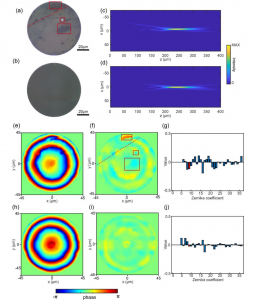Metalenses phase characterization by multi-distance phase retrieval
USA, August 7, 2024 /EINPresswire.com/ -- Metalens2 have gained significant attention for their unique functions and potential applications, and it is important to characterize the phase modulation of metalens. We present a phase characterization method of metalens based on field scanning. We extend our investigation to measure the phase distribution of the metalens operating in NIR and identify the impact of defects on phase. Additionally, we conduct a comparative analysis of the metalens in air and ethanol and observe the variations.
Metalens is a kind of optical metasurface composed of metaatoms for manipulating incoming light's amplitude, phase, and polarization. Unlike traditional refractive lenses, metalens can modulate the wavefront from plane to spherical at an interface. It has garnered widespread attention due to its novel physical properties and promising potential applications. As a phase-modulated optical functional component, phase distributions are the key parameter of metalens. However, in the optical frequency band, it is difficult to measure the phase distribution directly. Instead of measuring phase, the mainstream measurement methods for characterizing metalens currently involve light field scanning and electron microscopy. However, these methods do not directly provide the phase response of metalens.
In a new paper (https://doi.org/10.1038/s41377-024-01530-11) published in Light Science & Applications, the PBG Group at Fudan University, in collaboration with City University of Hong Kong and Tsinghua University, has a new phase characterization method for metalens based on multi-distance phase retrieval through optical field scanning. This innovative method successfully overcomes the limitations of traditional interferometric techniques, which rely on the coherence length of the light source and the stability of the optical path. Using this method, the research team quantitatively measured the phase distribution of a near-infrared metalens and, for the first time, successfully observed the phase changes induced by changes in the working medium of metalens.
The multi-distance phase retrieval system can measure the intensity distribution by translating the entire optical path. By measuring a series of equally spaced optical field intensity distributions starting from the sample surface and inputting them into an iterative algorithm, we can determine the phase distribution of the sample. This method is suitable for phase characterization of metalens with different design principles, operating wavelengths, and working media. The scientists summarized their work as follows.
"Compared to other phase characterization methods for metalens, our system has the following advantages: Unlike off-axis digital holography, our system is free from the constraints of the coherence length of the light source. Additionally, our system does not require the construction of complex optical paths, making it more cost-effective. Compared to wavefront sensors, our system does not need to introduce a diffraction grating for splitting light, resulting in higher energy utilization and avoiding the influence of the grating's morphology."
"Using the aforementioned method, we conducted phase measurements and wavefront error analysis on a set of near-infrared metalenses operating at a wavelength of 1560 nm. One sample exhibited defects during processing and storage, specifically manifesting as dirt and scratches on the surface. After measuring the phase and calculating the wavefront error, we determined the impact of the defects on the phase and computed the corresponding Zernike coefficients."
We measured the phase distribution of the same sample when immersed in both air and ethanol. Due to the change in the working medium, the phase distribution of the metalens exhibited significant alterations. Compared to its phase distribution in air, the sample displayed noticeable phase jumps when immersed in ethanol. This indicates that the phase modulation of some meta-atoms changes in different media. This is the first time that changes in metalens phase modulation due to variations in the working environment have been observed. This discovery provides a new perspective for understanding the optical behavior of metalenses in different media and offers important insights for the future design and application of metalenses.
DOI
10.1038/s41377-024-01530-1
Original Source URL
https://doi.org/10.1038/s41377-024-01530-11
Funding information
This work is supported by National Key R&D Program of China (2023YFA1406900 and 2022YFA1404800); the University Grants Committee / Research Grants Council of the Hong Kong Special Administrative Region, China (Project No. AoE/P-502/20, CRF Project: C1015-21E; C5031-22G; and GRF Project: CityU15303521; CityU11305223; CityU11310522; CityU11300123), and City University of Hong Kong (Project No. 9380131, 9610628, and 7005867), National Natural Science Foundation of China ( No. 62375232, No. 62305184, No. 12221004, No. 12234007 and No. 12321161645); Major Program of National Natural Science Foundation of China (Grant No. T2394480, T2394481); Science and Technology Commission of Shanghai Municipality (22142200400, 21DZ1101500, 2019SHZDZX01 and 23DZ2260100), Project funded by China Postdoctoral Science Foundation (BX20220093); Shanghai Yangfan Project (23YF1415300); Applied Basic Research Foundation of Guangdong Province(2023A1515012932); Science, Technology and Innovation Commission of Shenzhen Municipality(WDZC20220818100259004).
Lucy Wang
BioDesign Research
email us here
1 https://doi.org/10.1038/s41377-024-01530-1
2 https://doi.org/10.1038/s41377-024-01530-1


